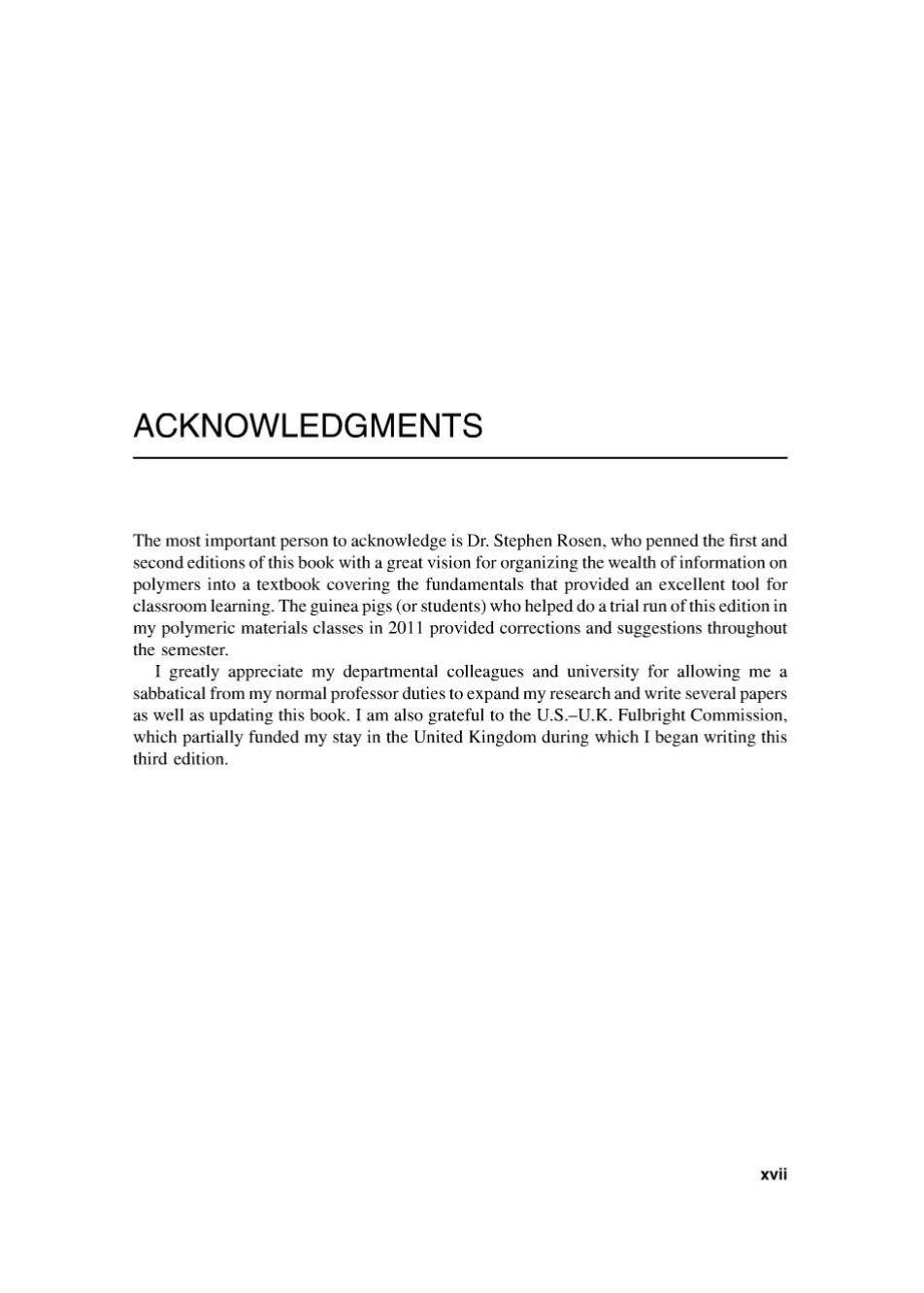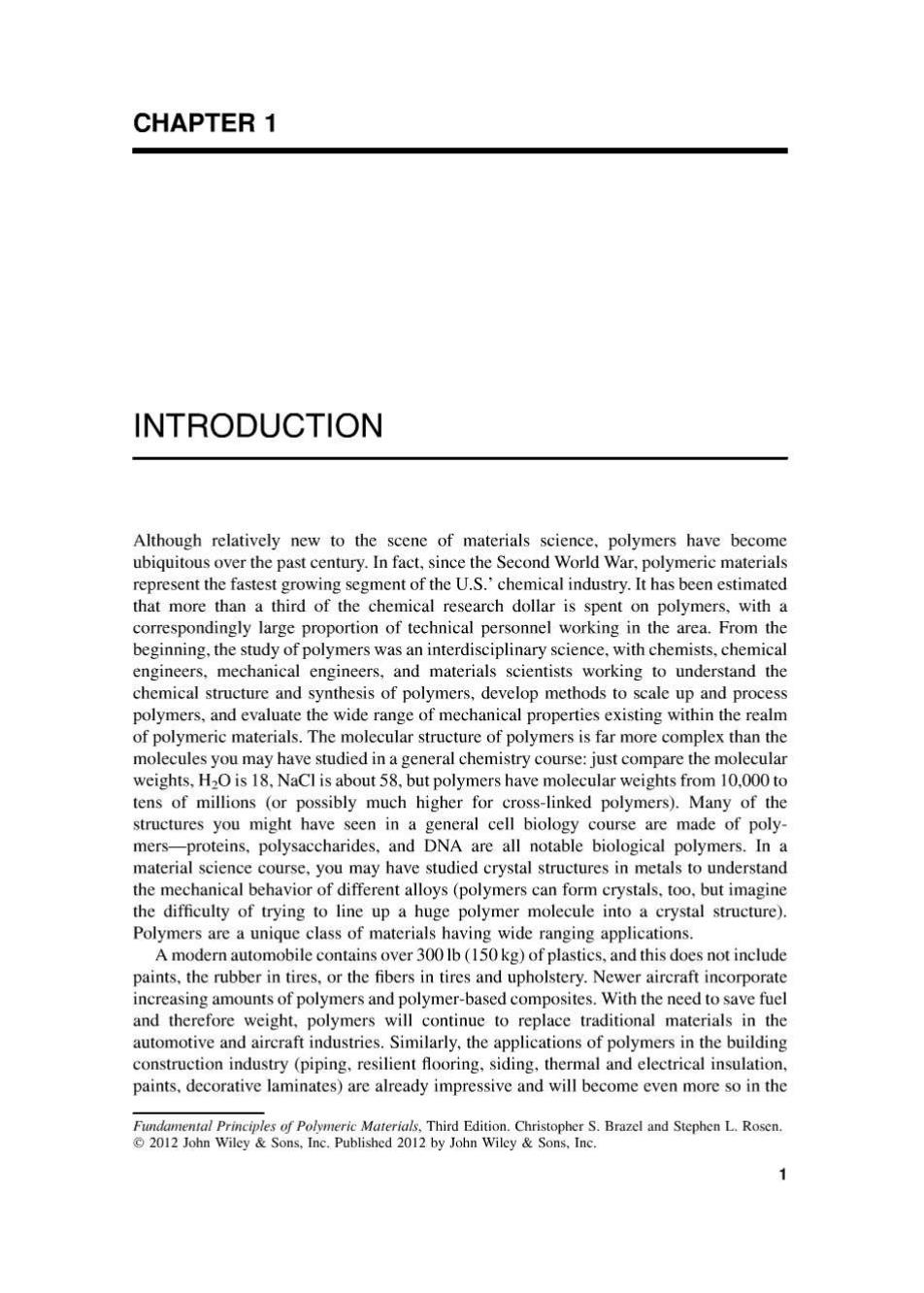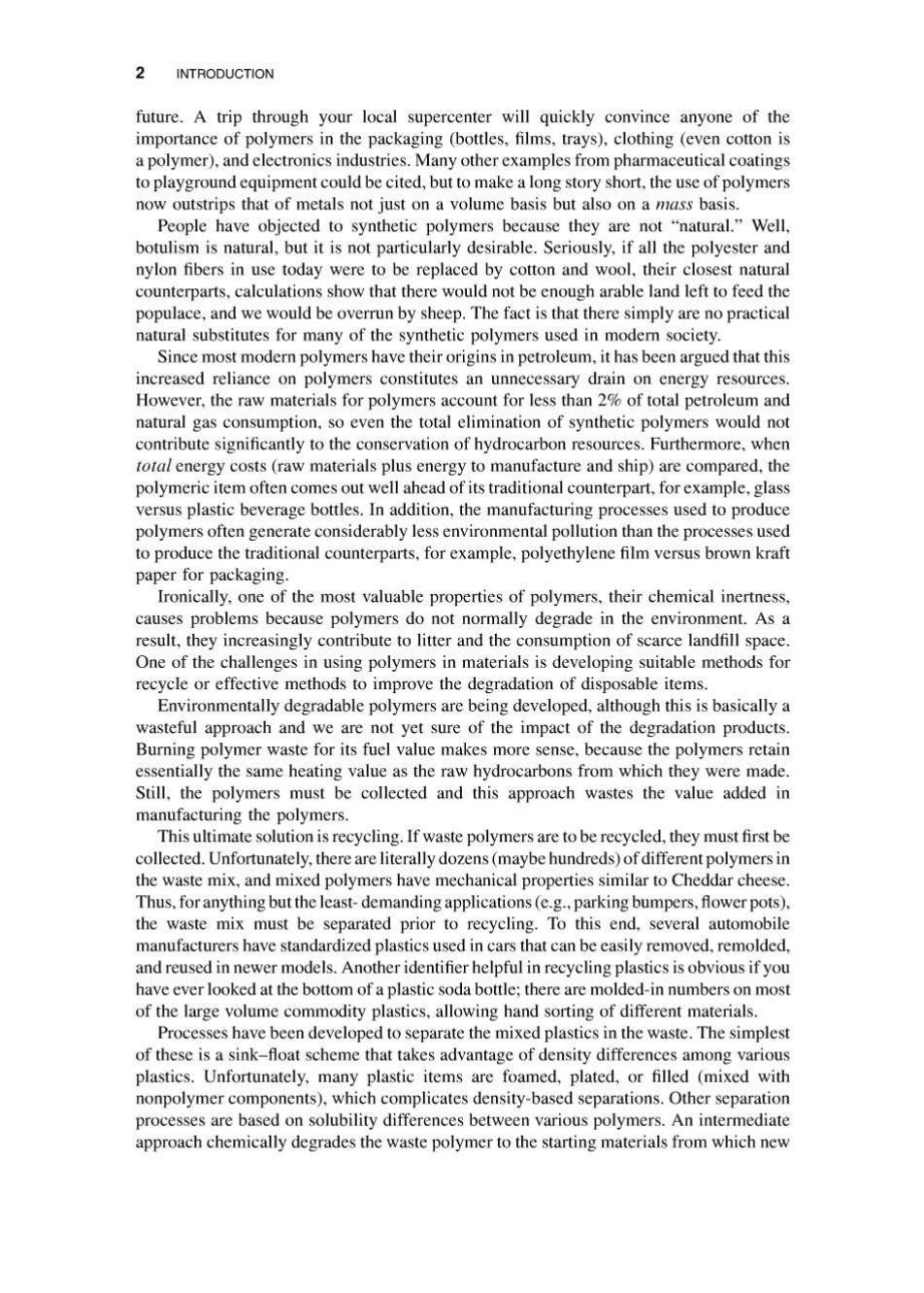
PREFACE TO THE SECOND EDITION This work was written to provide an appreciation of those fundamental principles of polymer science and engineering that are currently of practical relevance.I hope the reader will obtain both a broad,unified introduction to the subject matter that will be of immediate practical value and a foundation for more advanced study. A decade has passed since the publication of the first Wiley edition of this book.New developments in the polymer area during that decade justify an update.Having used the book in class during the period,I've thought of better ways of explaining some of the material,and these have been incorporated in this edition. But the biggest change with this edition is the addition of end-of-chapter problems at the suggestion of some academic colleagues.This should make the book more suitable as an academic text.Most of these problems are old homework problems or exam questions.I don't know what I'm going to do for new exam questions,but I'll think of something.Any suggestions for additional problems will be gratefully accepted. The first Wiley edition of this book in 1982 was preceded by a little paperback intended primarily as a self-study guide for practicing engineers and scientists.I sincerely hope that by adding material aimed at an academic audience I have not made the book less useful to that original audience.To this end,I have retained the worked-out problems in the chapters and added some new ones.I have tried to emphasize a qualitative understanding of the underlying principles before tackling the mathematical details,so that the former may be appreciated independently of the latter(I don't recommend trying it the other way around. however).and I have tried to include practical illustrations of the material whenever possible. In this edition,previous material has been generally updated.In view of commercial developments over the decade,the discussion of extended-chain crystals has been increased and a section on liquid-crystal polymers has been added.The discussion of phase behavior in polymer-solvent systems has been expanded and the Flory-Huggins theory is introduced.All kinetic expressions are now written in terms of conversion(rather than monomer concentration)for greater generality and ease of application.Also.in XV

xvi PREFACE TO THE SECOND EDITION deference to the ready availability of numerical-solution software,kinetic expressions now incorporate the possibility of a variable-volume reaction mass,and the effects of variable volume are illustrated in several examples.A section on group-transfer polymerization has been added and a quantitative treatment of Ziegler-Natta polymerization has been attempted for the first time,including three new worked-out examples.Processes based on these catalysts are presented in greater detail.The "modified Cross"model,giving viscosity as a function of both shear rate and temperature,is introduced and its utility is illustrated.A section on scaleup calculations for the laminar flow of non-Newtonian fluids has been added,including two worked-out examples.The discussion of three-dimensional stress and strain has been expanded and includes two new worked-out examples. Tobolsky's "Procedure X"for extracting discrete relaxation times and moduli from data is introduced. Obviously,the choice of material to be covered involves subjective judgment on the part of the author.This,together with space limitations and the rapid expansion of knowledge in the field,has resulted in the omission or shallow treatment of many interesting subjects.I apologize to friends and colleagues who have suggested incorporation of their work but don't find it here.Generally,it's fine work,but too specialized for a book of this nature.The end-of-chapter references are chosen to aid the reader who wishes to pursue a subject in greater detail. I have used the previous edition to introduce the macromolecular gospel to a variety of audiences.Parts 1,2 and most of 3 were covered in a one-semester course with chemistry and chemical engineering seniors and graduate students at Carnegie-Mellon.At Toledo, Parts I and 2 were covered in a one-quarter course with chemists and chemical engineers.A second quarter covered Part 3 with additional quantitative material on processing added. The audience for this included chemical and mechanical engineers (we didn't mention chemical reactions).Finally,I covered Parts I and 3 in one quarter with a diverse audience of graduate engineers at the NASA-Lewis Research Labs. A word to the student:To derive maximum benefit from the worked-out examples,make an honest effort to answer them before looking at the solutions.If you can't do one,you've missed some important points in the preceding material,and you ought to go back over it. STEPHEN L.ROSEN Rolla.Missouri November 1992

ACKNOWLEDGMENTS The most important person to acknowledge is Dr.Stephen Rosen,who penned the first and second editions of this book with a great vision for organizing the wealth of information on polymers into a textbook covering the fundamentals that provided an excellent tool for classroom learning.The guinea pigs(or students)who helped do a trial run of this edition in my polymeric materials classes in 2011 provided corrections and suggestions throughout the semester. I greatly appreciate my departmental colleagues and university for allowing me a sabbatical from my normal professor duties to expand my research and write several papers as well as updating this book.I am also grateful to the U.S.-U.K.Fulbright Commission, which partially funded my stay in the United Kingdom during which I began writing this third edition. xvii

CHAPTER 1 INTRODUCTION Although relatively new to the scene of materials science,polymers have become ubiquitous over the past century.In fact,since the Second World War,polymeric materials represent the fastest growing segment of the U.S.'chemical industry.It has been estimated that more than a third of the chemical research dollar is spent on polymers,with a correspondingly large proportion of technical personnel working in the area.From the beginning,the study of polymers was an interdisciplinary science,with chemists,chemical engineers,mechanical engineers,and materials scientists working to understand the chemical structure and synthesis of polymers,develop methods to scale up and process polymers,and evaluate the wide range of mechanical properties existing within the realm of polymeric materials.The molecular structure of polymers is far more complex than the molecules you may have studied in a general chemistry course:just compare the molecular weights,H2O is 18,NaCl is about 58,but polymers have molecular weights from 10,000 to tens of millions (or possibly much higher for cross-linked polymers).Many of the structures you might have seen in a general cell biology course are made of poly- mers-proteins,polysaccharides,and DNA are all notable biological polymers.In a material science course,you may have studied crystal structures in metals to understand the mechanical behavior of different alloys(polymers can form crystals.too,but imagine the difficulty of trying to line up a huge polymer molecule into a crystal structure). Polymers are a unique class of materials having wide ranging applications. A modern automobile contains over 300 lb(150 kg)of plastics,and this does not include paints,the rubber in tires,or the fibers in tires and upholstery.Newer aircraft incorporate increasing amounts of polymers and polymer-based composites.With the need to save fuel and therefore weight,polymers will continue to replace traditional materials in the automotive and aircraft industries.Similarly,the applications of polymers in the building construction industry (piping,resilient flooring,siding,thermal and electrical insulation, paints,decorative laminates)are already impressive and will become even more so in the Fundamental Principles of Polymeric Materials,Third Edition.Christopher S.Brazel and Stephen L.Rosen. 2012 John Wiley Sons,Inc.Published 2012 by John Wiley Sons,Inc

2 INTRODUCTION future.A trip through your local supercenter will quickly convince anyone of the importance of polymers in the packaging (bottles,films,trays),clothing (even cotton is a polymer),and electronics industries.Many other examples from pharmaceutical coatings to playground equipment could be cited,but to make a long story short,the use of polymers now outstrips that of metals not just on a volume basis but also on a mass basis. People have objected to synthetic polymers because they are not "natural."Well, botulism is natural,but it is not particularly desirable.Seriously,if all the polyester and nylon fibers in use today were to be replaced by cotton and wool,their closest natural counterparts,calculations show that there would not be enough arable land left to feed the populace,and we would be overrun by sheep.The fact is that there simply are no practical natural substitutes for many of the synthetic polymers used in modern society. Since most modern polymers have their origins in petroleum,it has been argued that this increased reliance on polymers constitutes an unnecessary drain on energy resources However,the raw materials for polymers account for less than 2%of total petroleum and natural gas consumption,so even the total elimination of synthetic polymers would not contribute significantly to the conservation of hydrocarbon resources.Furthermore,when total energy costs(raw materials plus energy to manufacture and ship)are compared,the polymeric item often comes out well ahead of its traditional counterpart,for example,glass versus plastic beverage bottles.In addition,the manufacturing processes used to produce polymers often generate considerably less environmental pollution than the processes used to produce the traditional counterparts,for example,polyethylene film versus brown kraft paper for packaging. Ironically,one of the most valuable properties of polymers,their chemical inertness, causes problems because polymers do not normally degrade in the environment.As a result,they increasingly contribute to litter and the consumption of scarce landfill space. One of the challenges in using polymers in materials is developing suitable methods for recycle or effective methods to improve the degradation of disposable items. Environmentally degradable polymers are being developed,although this is basically a wasteful approach and we are not yet sure of the impact of the degradation products. Burning polymer waste for its fuel value makes more sense,because the polymers retain essentially the same heating value as the raw hydrocarbons from which they were made. Still,the polymers must be collected and this approach wastes the value added in manufacturing the polymers. This ultimate solution is recycling.If waste polymers are to be recycled,they must first be collected.Unfortunately,there are literally dozens(maybe hundreds)of different polymers in the waste mix,and mixed polymers have mechanical properties similar to Cheddar cheese Thus,for anything but the least-demanding applications(e.g.,parking bumpers,flower pots), the waste mix must be separated prior to recycling.To this end,several automobile manufacturers have standardized plastics used in cars that can be easily removed,remolded. and reused in newer models.Another identifier helpful in recycling plastics is obvious if you have ever looked at the bottom of a plastic soda bottle;there are molded-in numbers on most of the large volume commodity plastics,allowing hand sorting of different materials. Processes have been developed to separate the mixed plastics in the waste.The simplest of these is a sink-float scheme that takes advantage of density differences among various plastics.Unfortunately,many plastic items are foamed,plated,or filled (mixed with nonpolymer components),which complicates density-based separations.Other separation processes are based on solubility differences between various polymers.An intermediate approach chemically degrades the waste polymer to the starting materials from which new